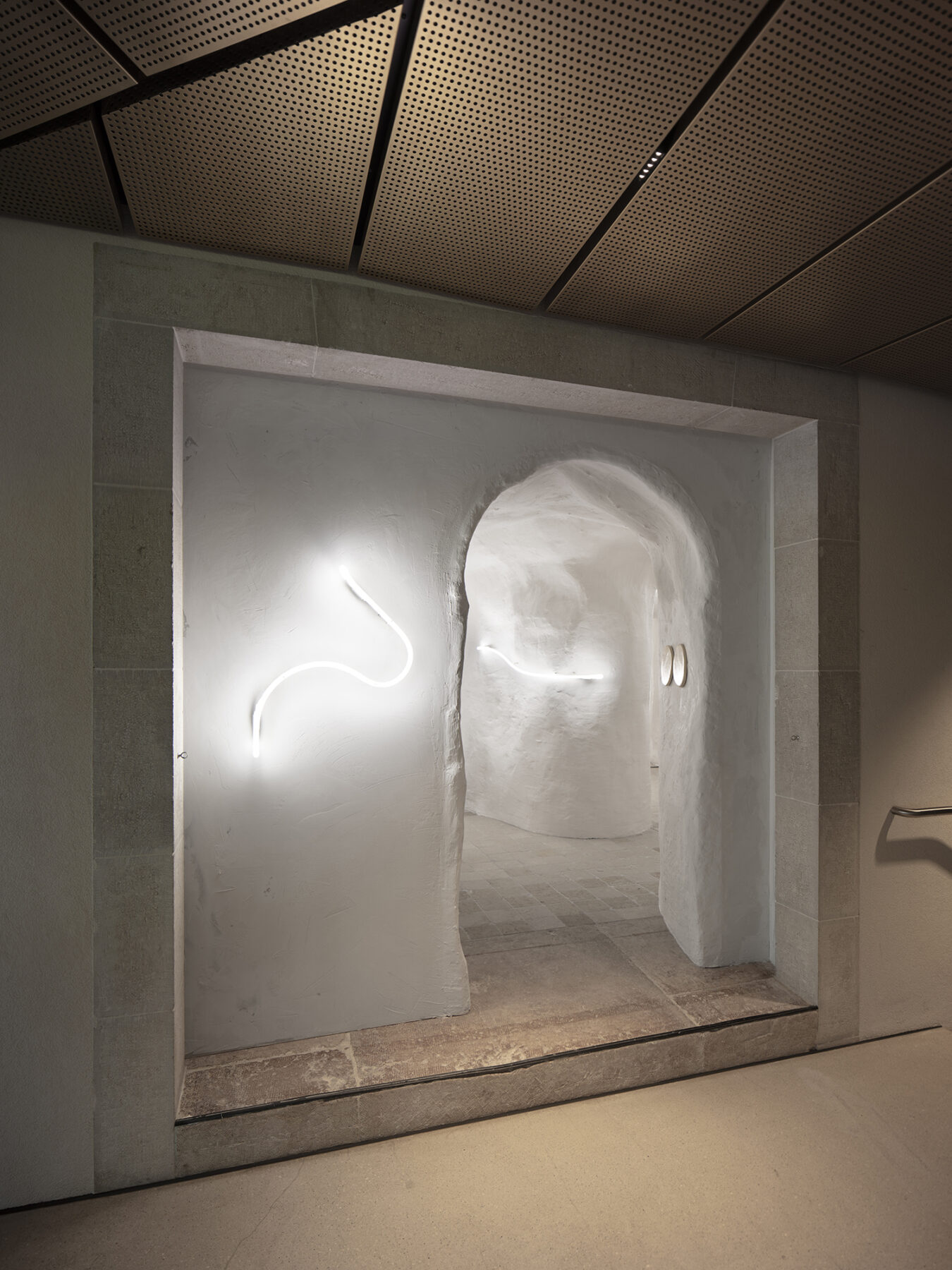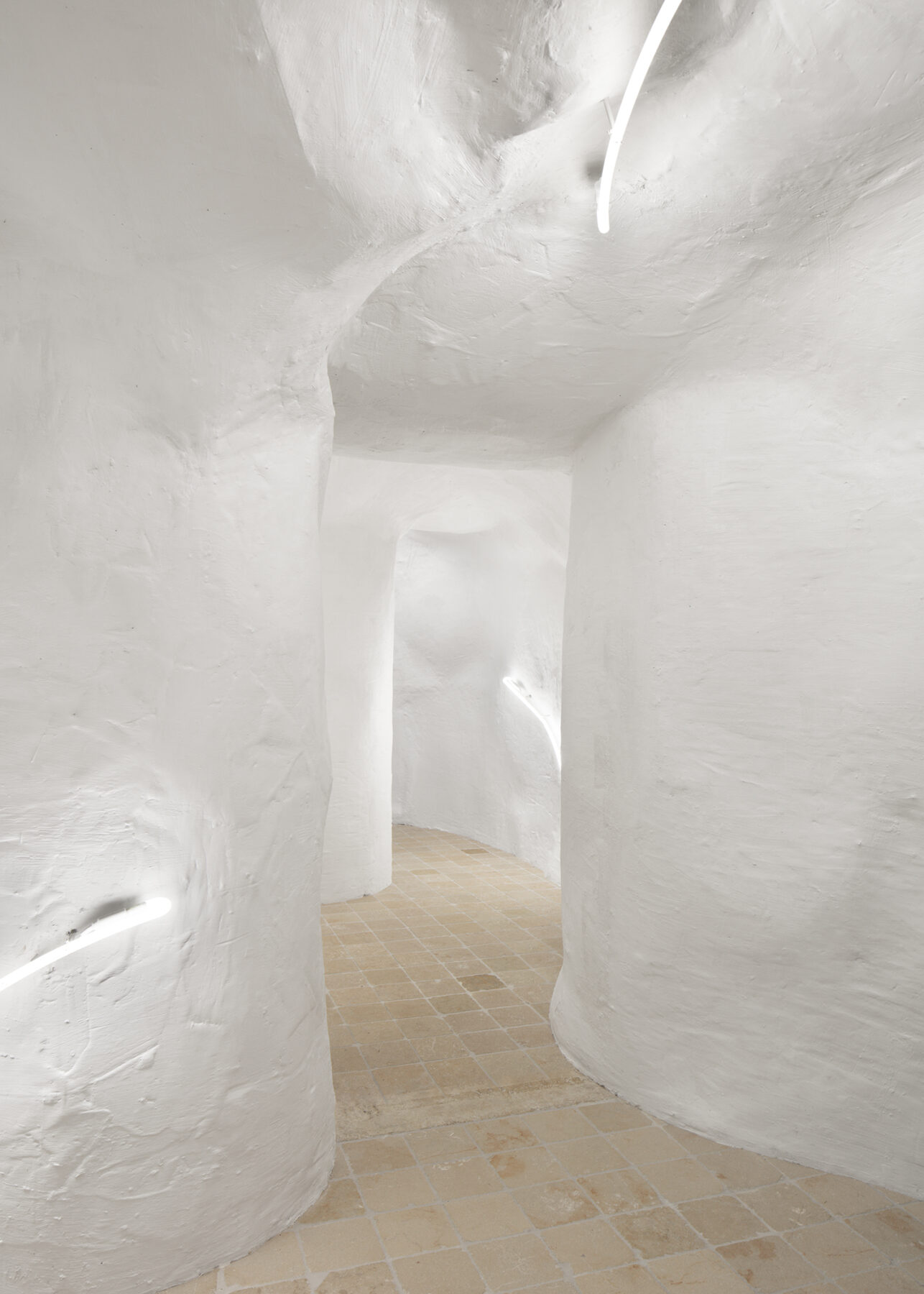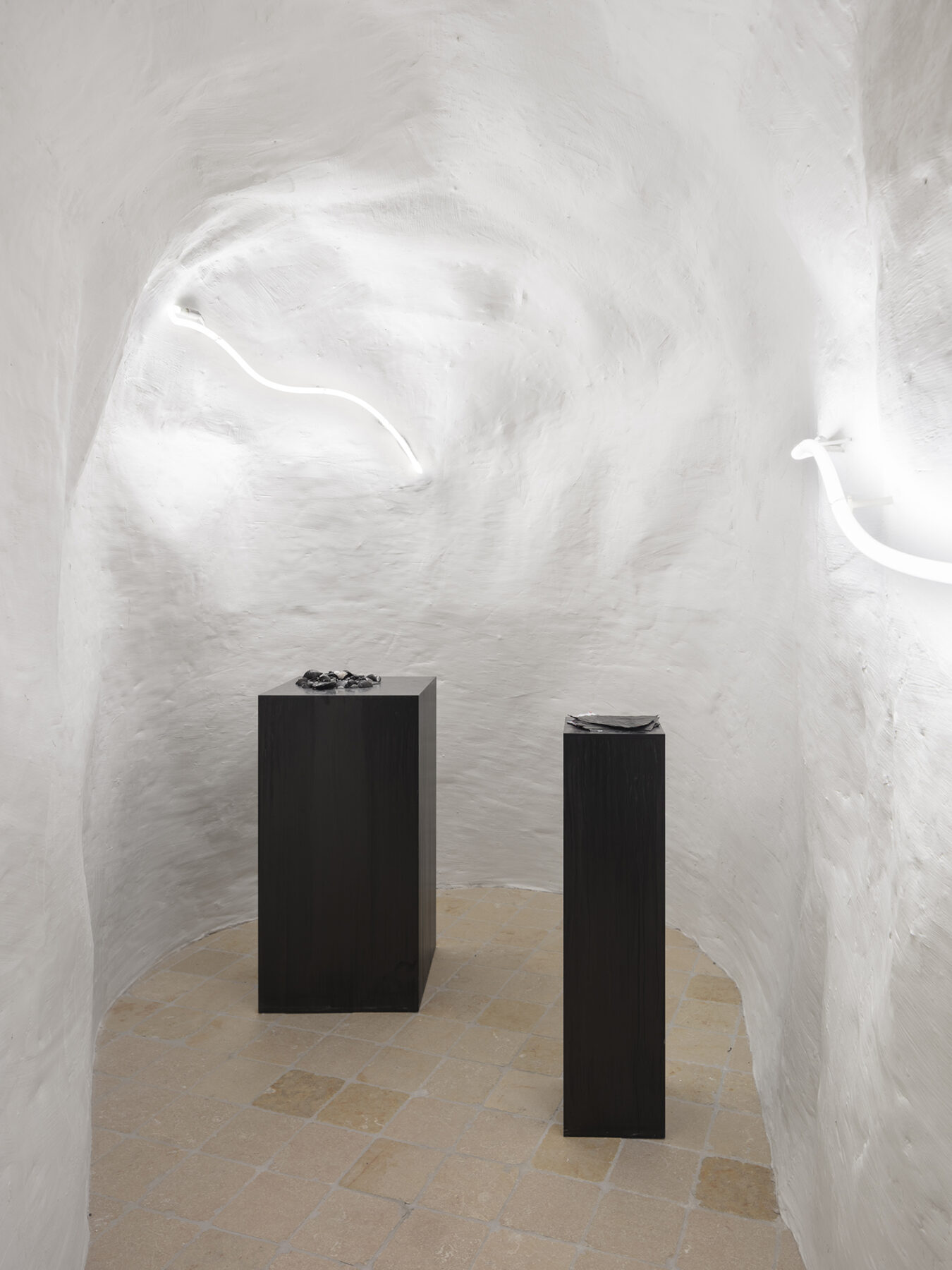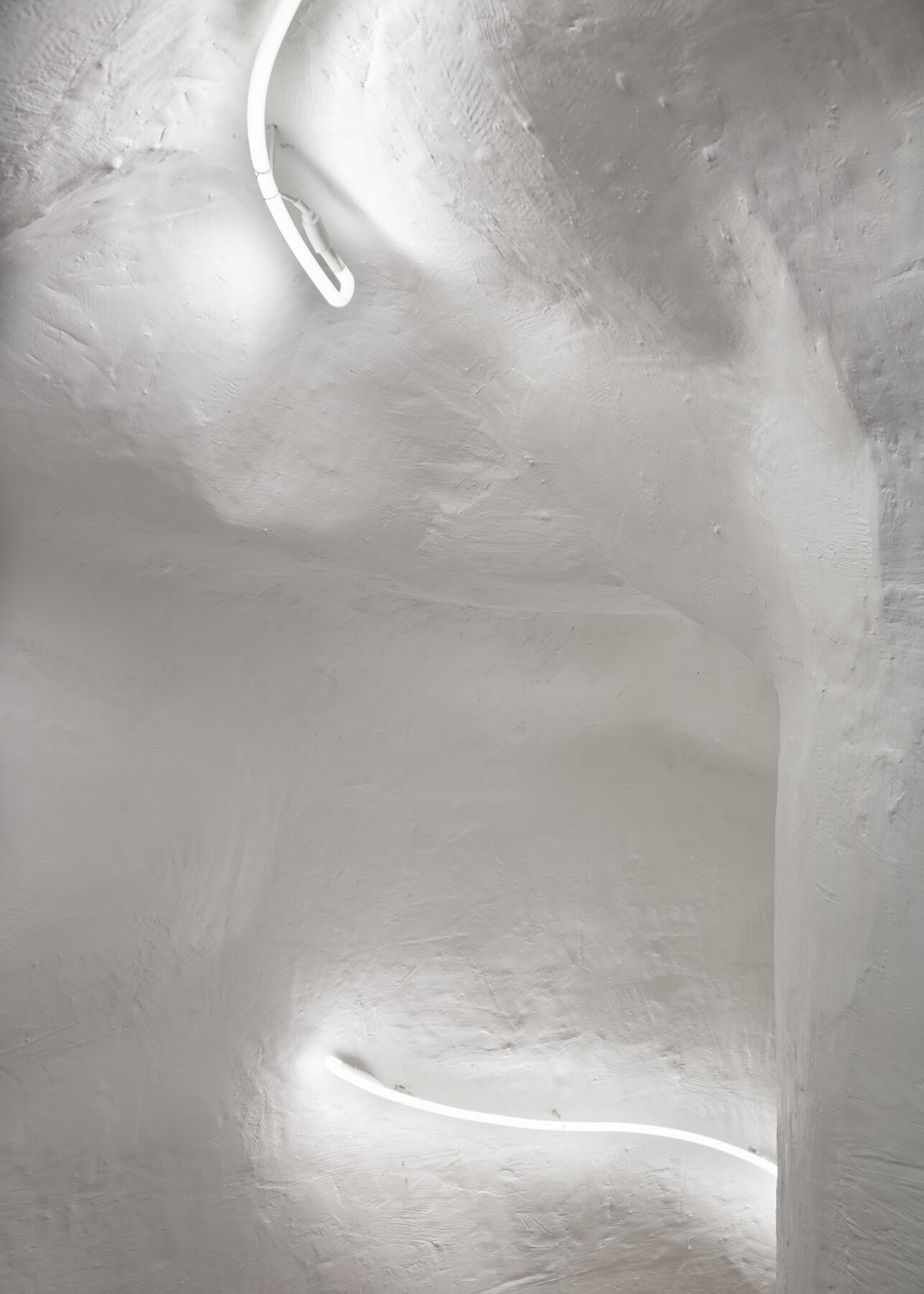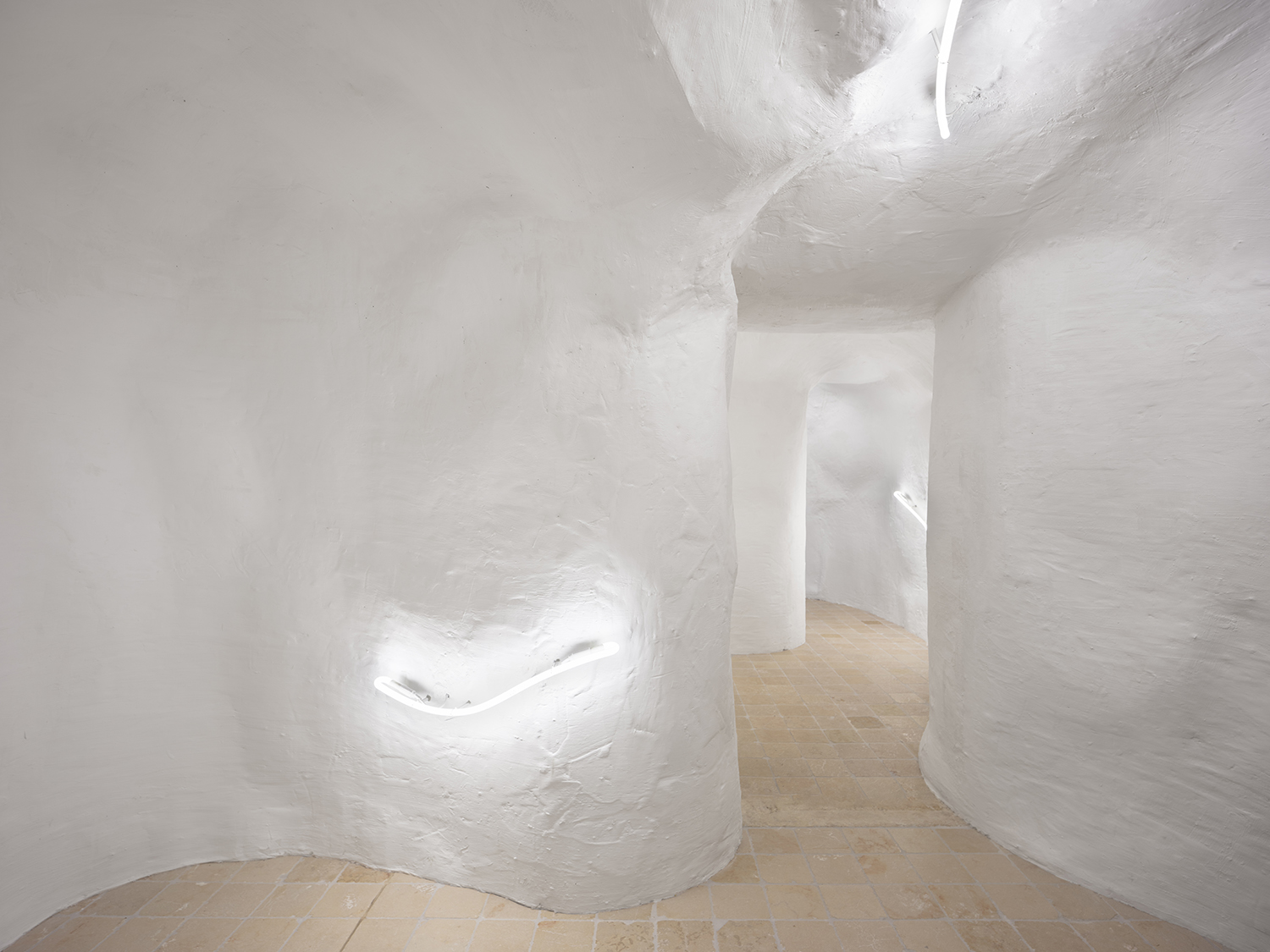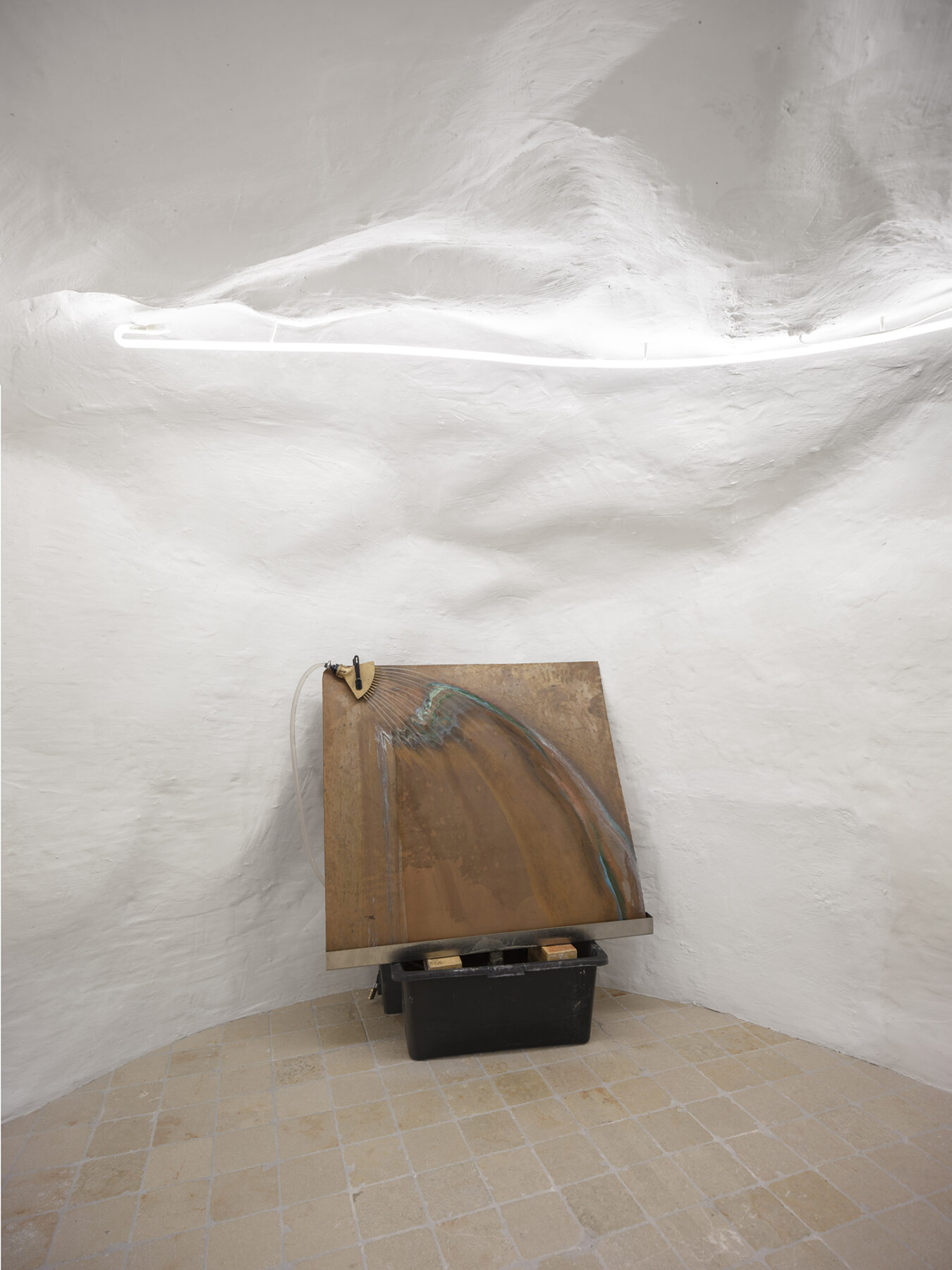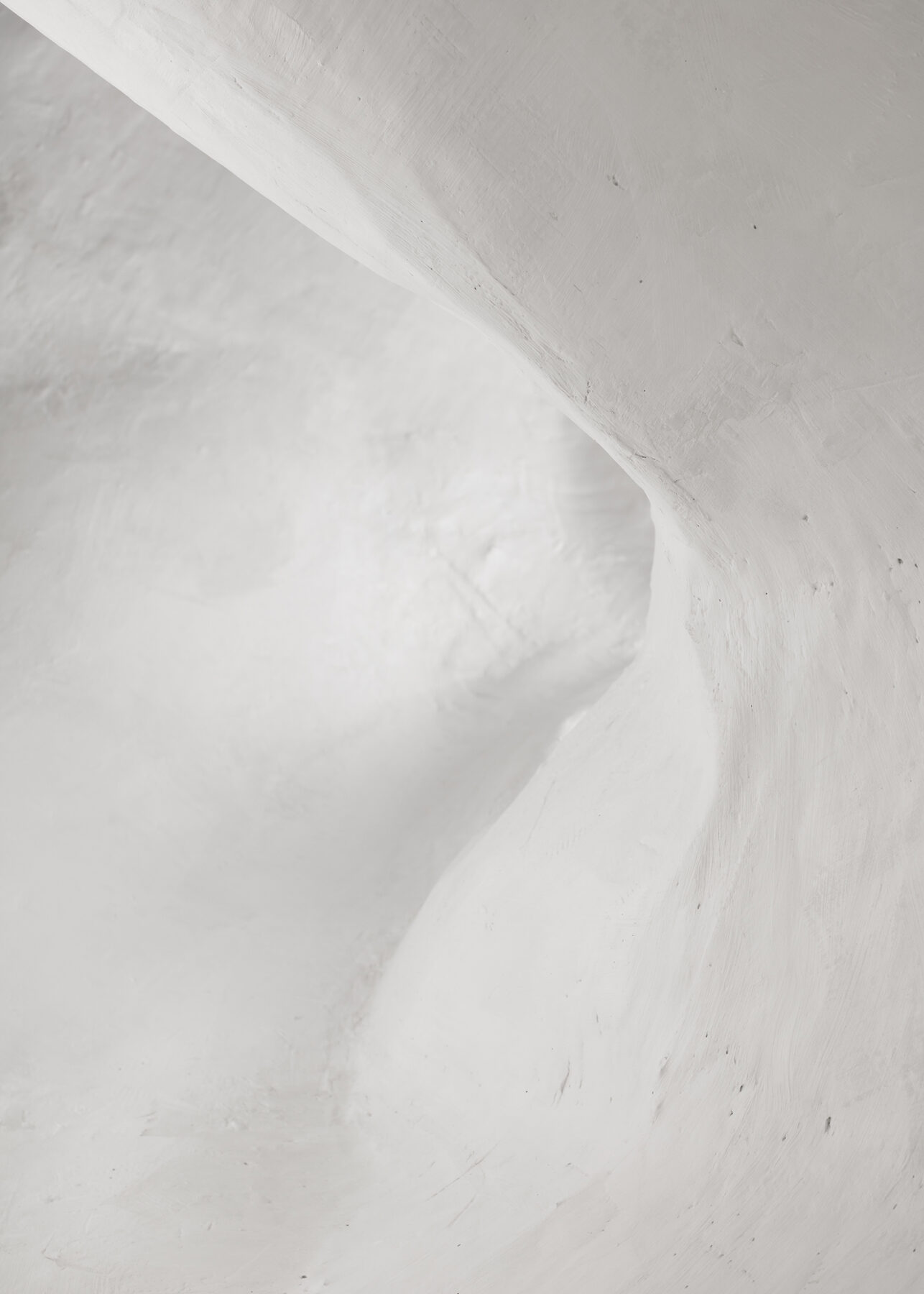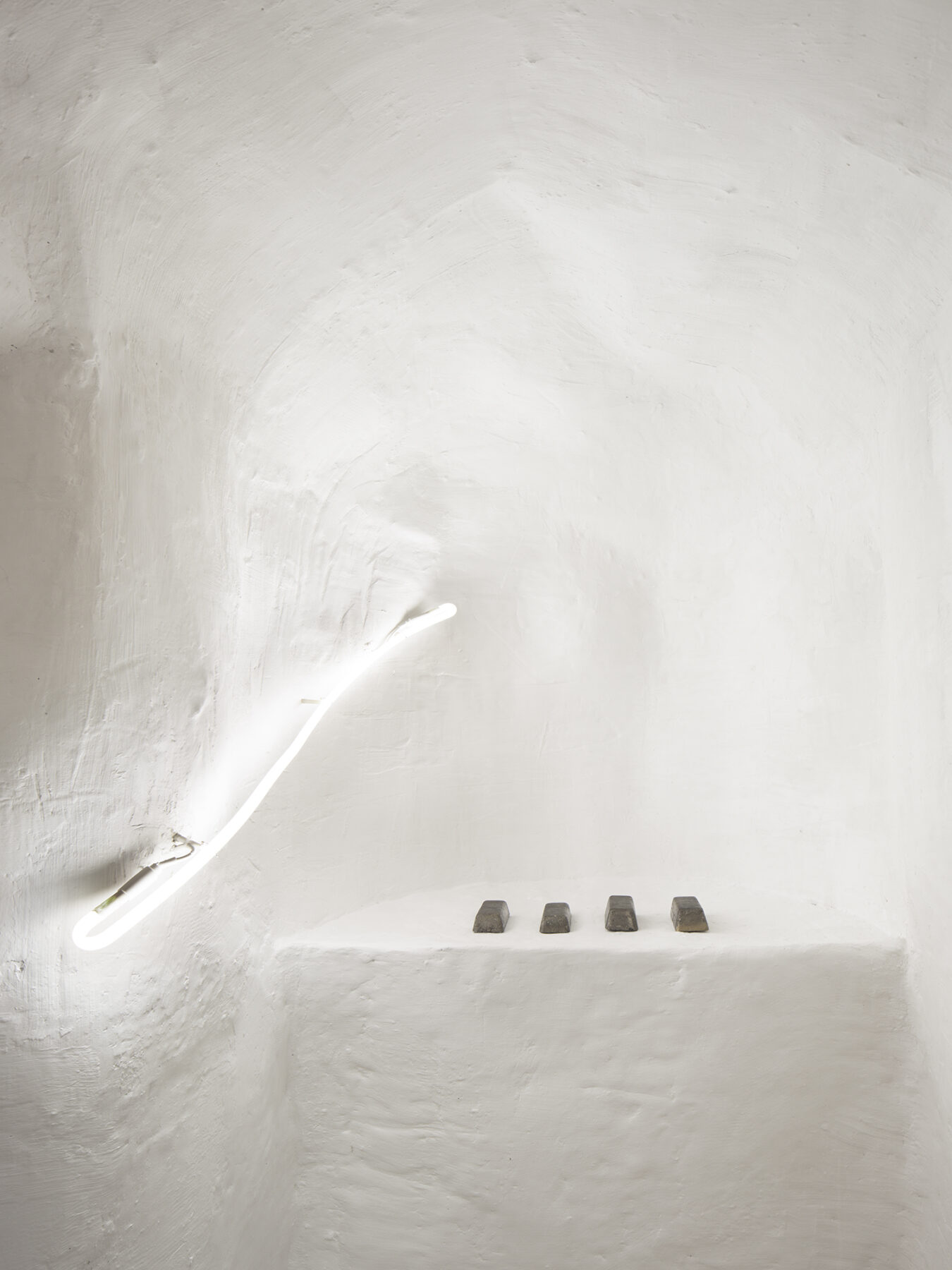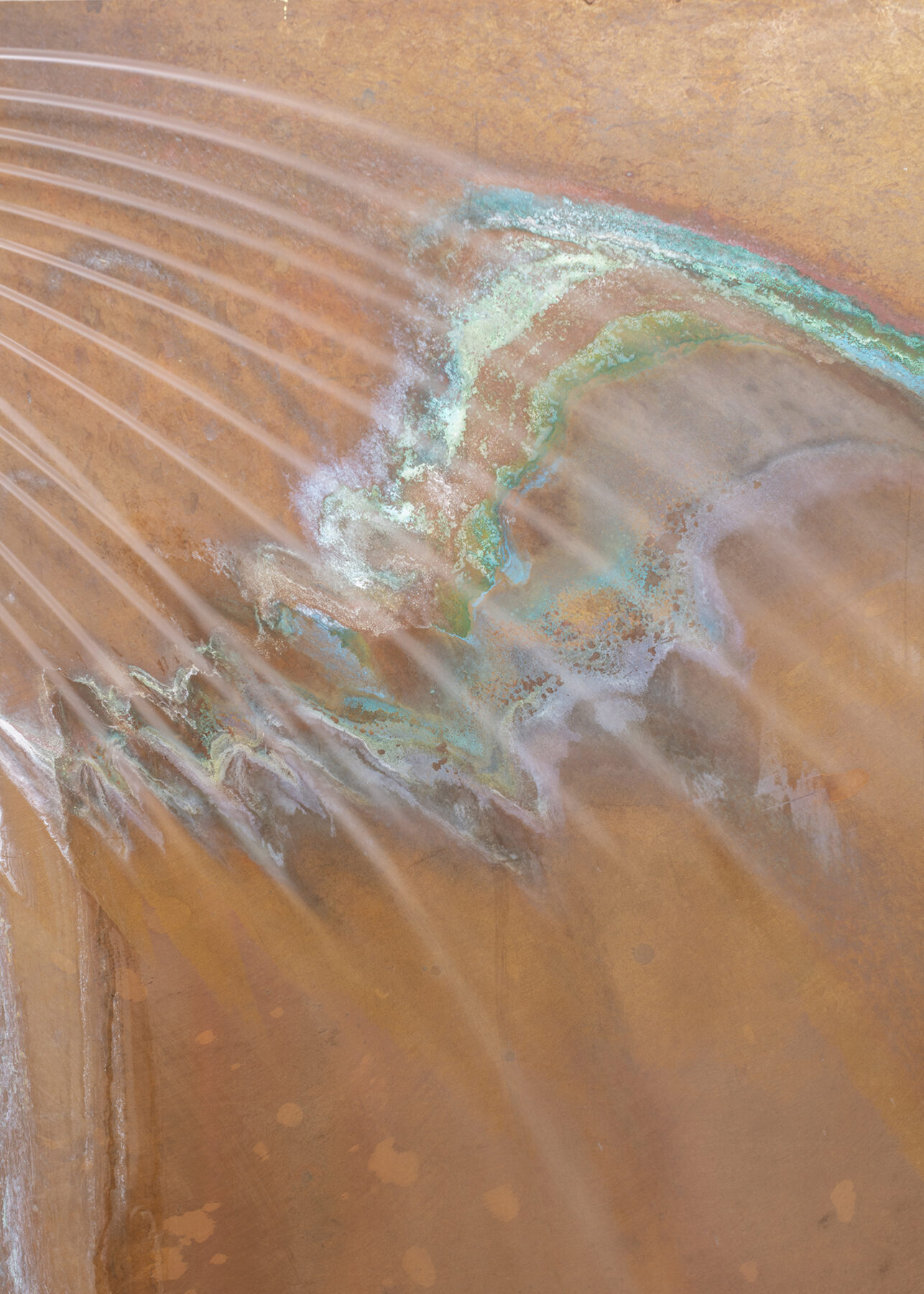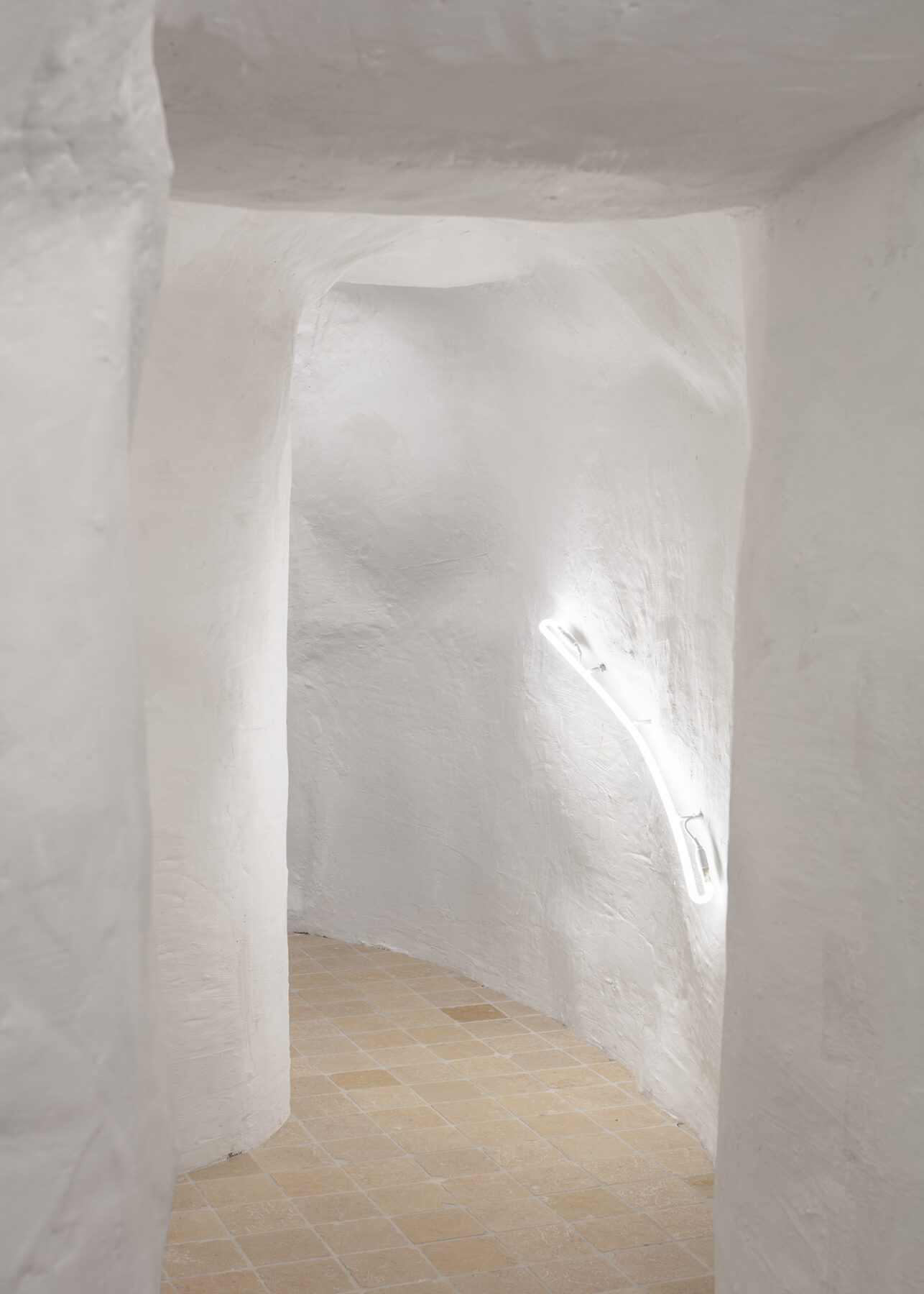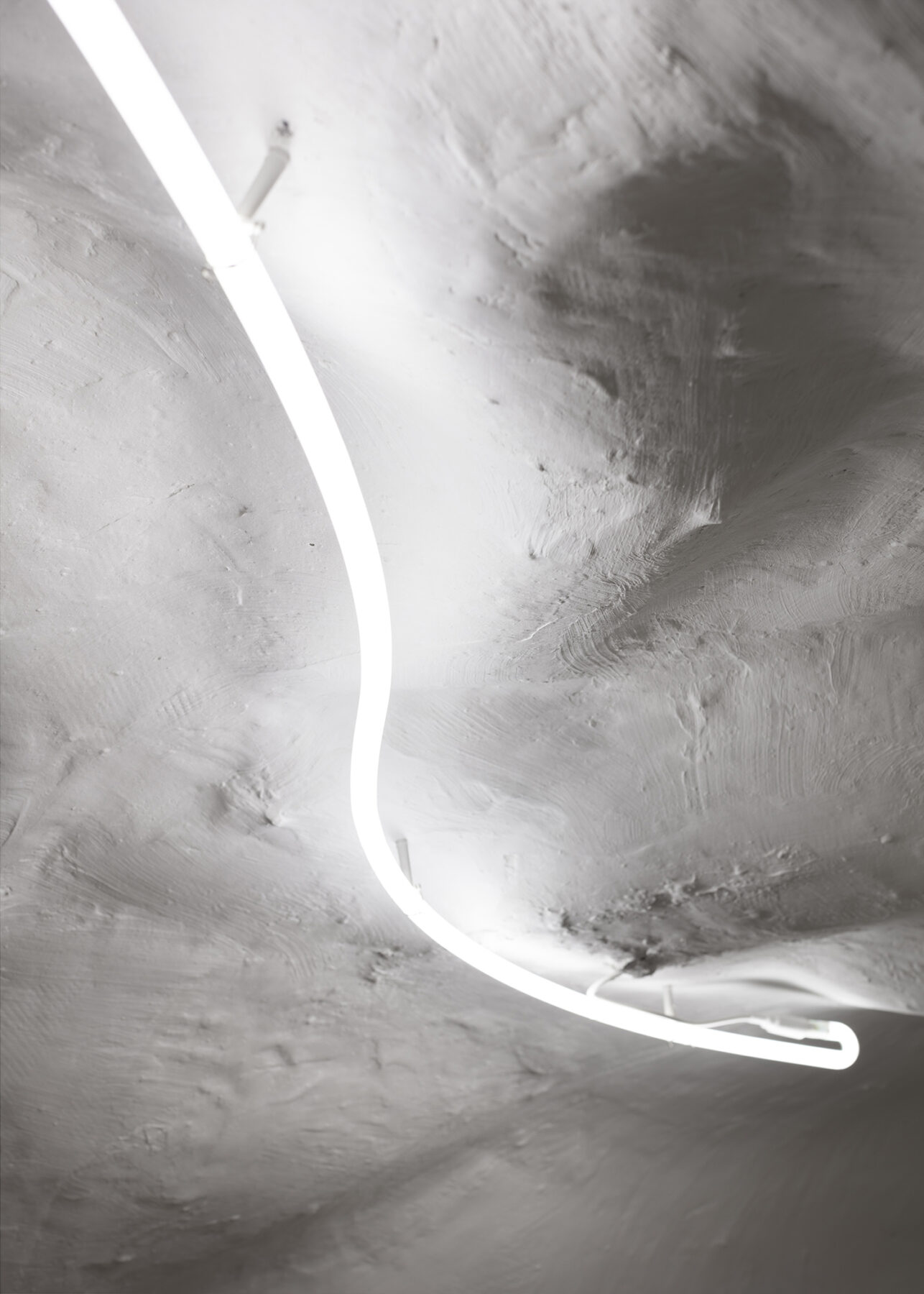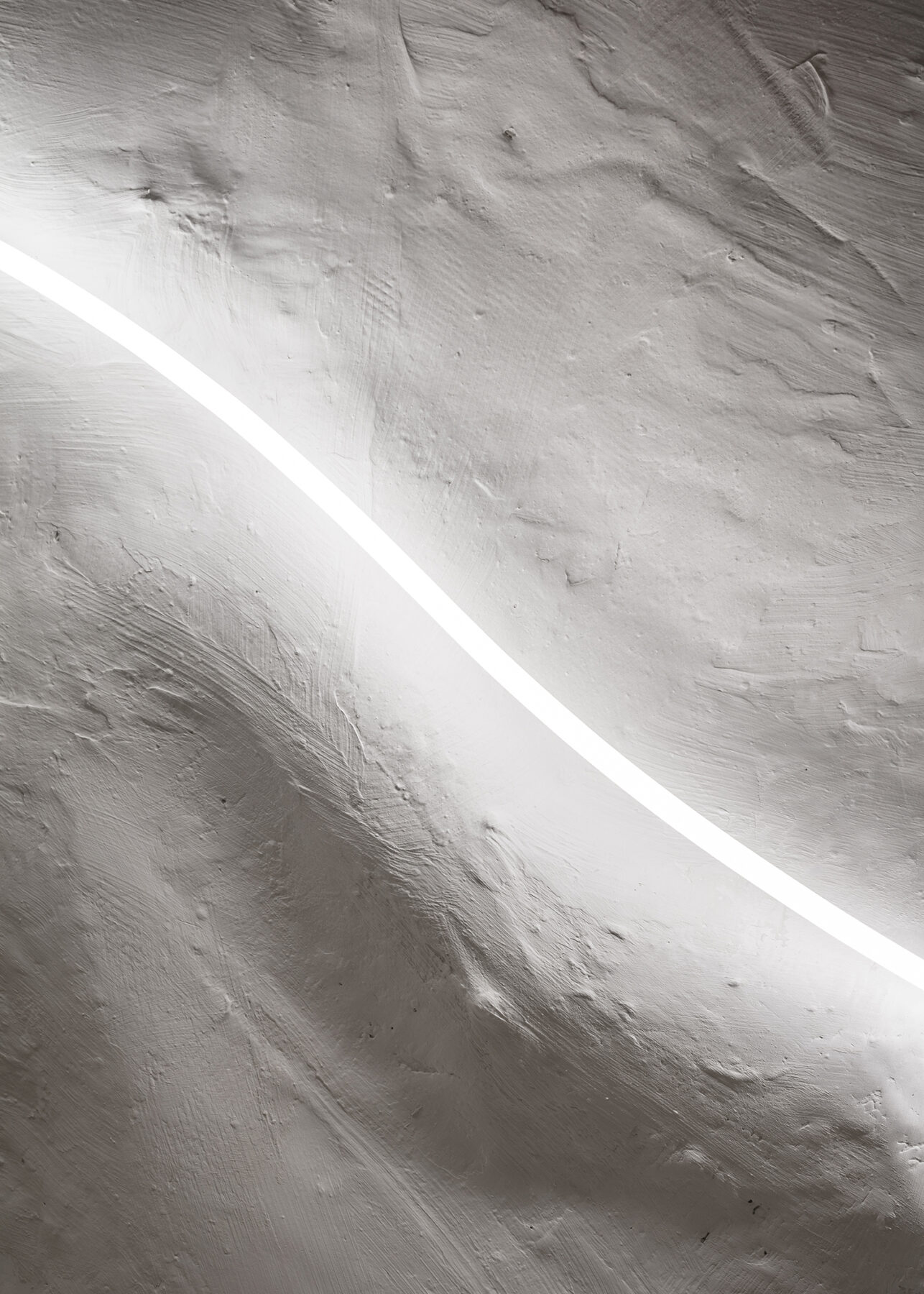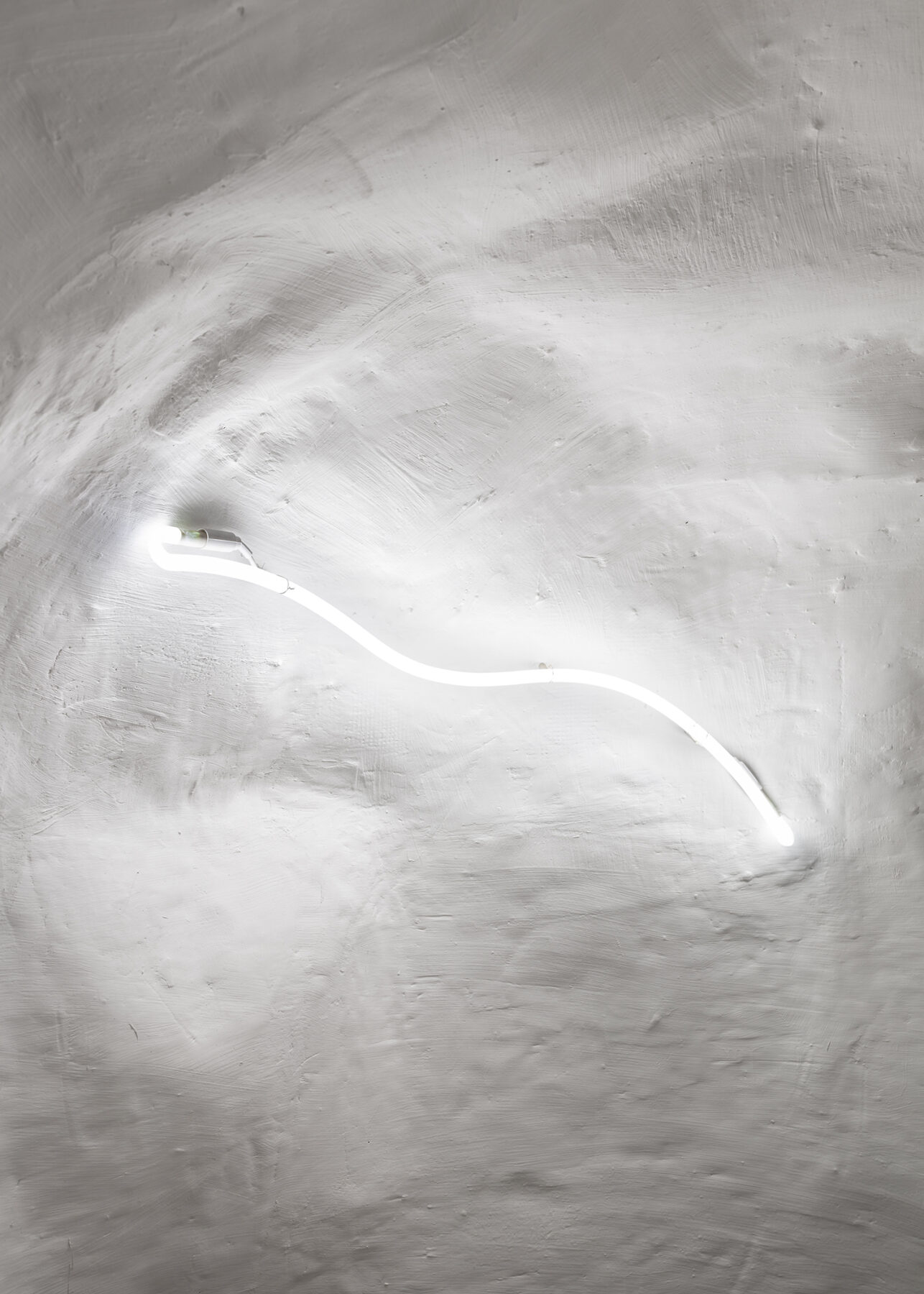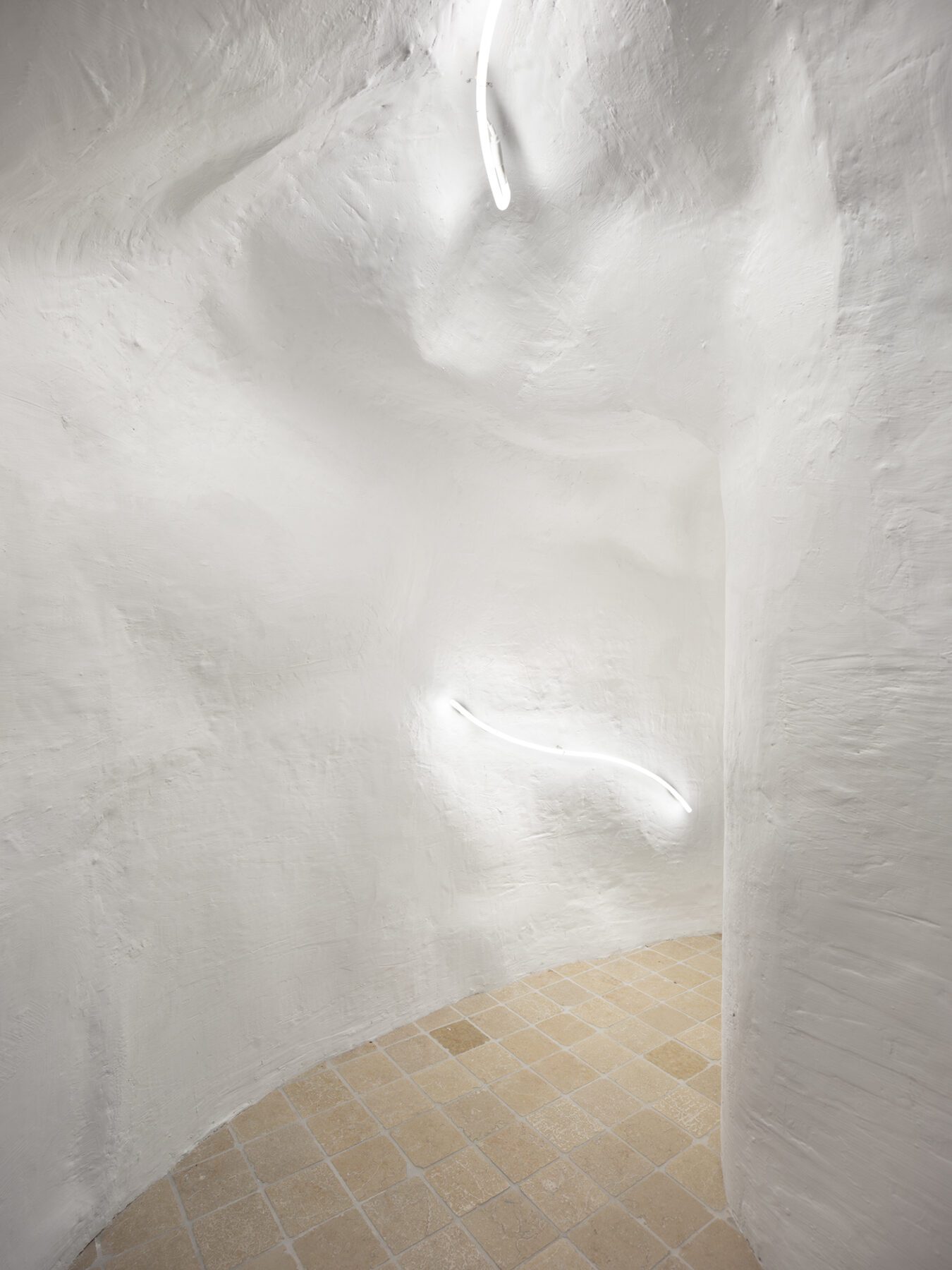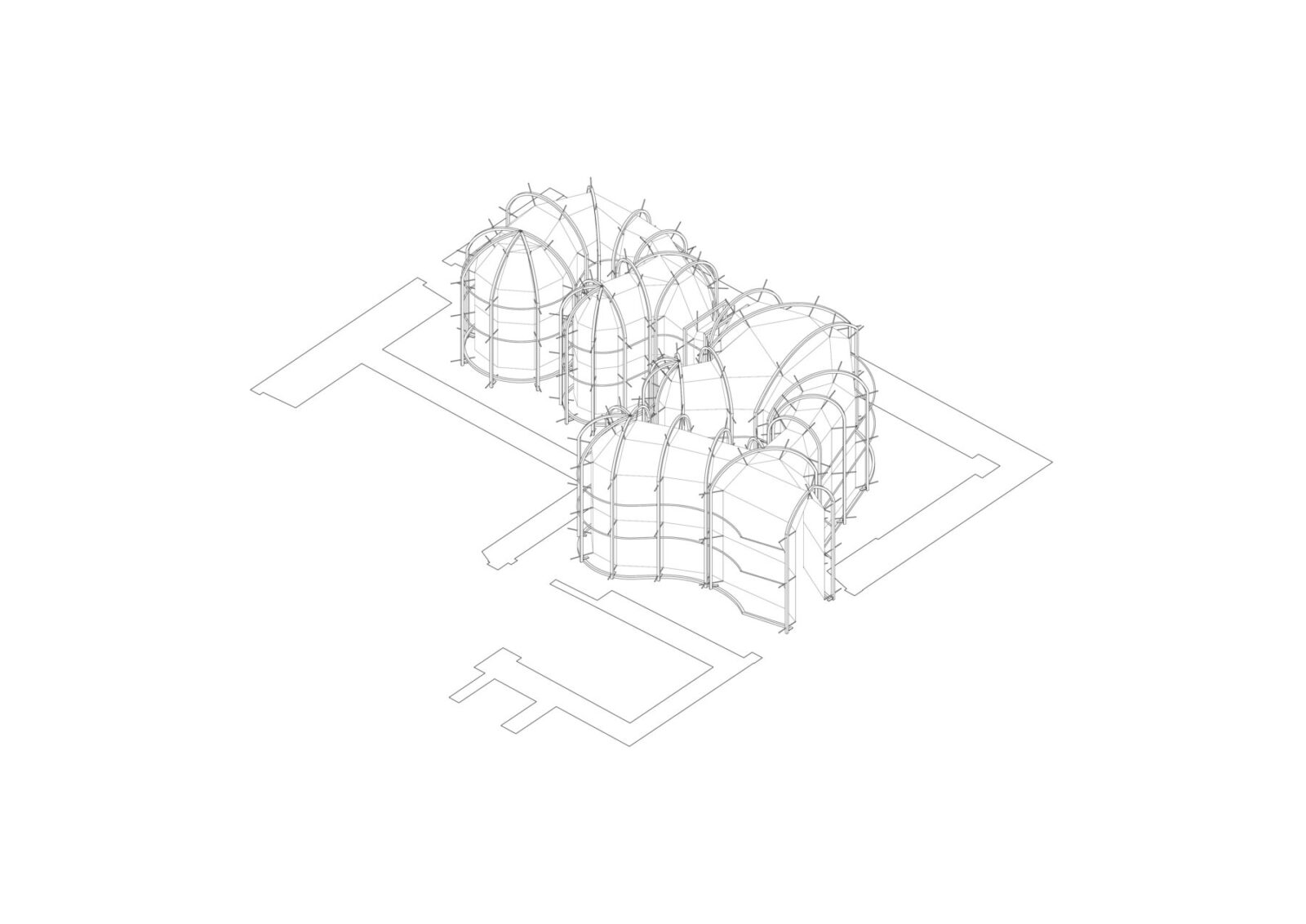Με αφορμή την έκθεση τέχνης ‘Selenite Dreams’, που έλαβε χώρα στο Musée Atelier Audemars Piguet στην Ελβετία τον Μάρτιο 2023, το γραφείο BUREAU σχεδίασε ένα σπηλαιώδες σκηνικό ως ωδή στις υλικές και συμβολικές ιδιότητες του γύψου (σοβά) και στη συνεισφορά του σε μια “ελάχιστη αρχιτεκτονική”*.
-γράφει η Μελίνα Αρβανίτη-Πολλάτου
Ξεκινώντας από μια υπαρξιακή προσέγγιση, για τον σχεδιασμό της έκθεσης, οι BUREAU ορίζουν εαυτούς αρχιτέκτονες του ελαχίστου και επιλέγουν ένα τετριμμένο, καθημερινό υλικό όπως ο γύψος για να κατασκευάσουν μια αρχιτεκτονική εύπλαστη, οργανική, εύθραυστη.
Αντλώντας αναφορές από το παβίλιον που σχεδίασε ο Salvador Dalí, το 1939, για την έκθεση παγκοσμίου εμβέλειας ‘World of the Tomorrow’ και τις μυθολογικές προεκτάσεις του σελενίτη (ορυκτού μετάλλου συνώνυμου του γύψου), οι αρχιτέκτονες ρευστοποιούν το απόλυτο του «λευκού κύβου» της γκαλερί σε μια συνεχή γεώδη τρισδιάστατη τοπογραφία που μεταφέρει τον επισκέπτη σαν άλλη Αλίκη στη χώρα των θαυμάτων περιελίσσοντας τον ανάμεσα στα έργα τέχνης των Nina Beier, Latifa Echakhch, Raphael Hefti, Olivier Laric και Χριστόδουλου Παναγιώτου (μεταξύ άλλων).
Ακολουθώντας την ποιητική προσέγγιση της Jill Stoner για μια αρχιτεκτονική που προκύπτει μέσα στη γλώσσα των κυρίαρχων αρχιτεκτονικών παραδειγμάτων αποδομώντας τις σχέσεις εξουσίας, που αδιάκοπα τα αναπαράγουν και τα επιτελούν, οι BUREAU παραθέτουν μια ελάχιστη χωρική δομή σε αντιπαράθεση με το ρωμαλέο αρχιτεκτονικό συγκείμενο εναπόθεσης της σχεδιασμένο από το διεθνώς αναγνωρισμένο γραφείο Bjarke Ingels Group.
«Γεννημένες από συλλογικές επιθυμίες, καθοδηγούμενες από την αβεβαιότητα του χρόνου και αποθεώνοντας την ενδεχομενικότητα» οι ελάχιστες αρχιτεκτονικές είναι όπως οι ελάχιστες λογοτεχνίες: ποιητικές, αποσπασματικές, συμπυκνωμένες, αξέχαστες, μαγευτικές.
* Ο όρος “ελάχιστη αρχιτεκτονική” χρησιμοποιείται σε άμεση σύνδεση με το βιβλίο της Jill Stoner, Toward a minor architecture (2012, The MIT Press).
Στοιχεία έργου
Τίτλος έργου Selenite Dreams
Τυπολογία Σχεδιασμός έκθεσης, Εσωτερικά
Τοποθεσία Musée Atelier Audemars Piguet, Brassus, Ελβετία
Εμβαδόν 24 τ.μ.
Κατάσταση Ολοκληρωμένο, 2022
Ομάδα έργου BUREAU (Daniel Zamarbide, Carine Pimenta, Galliane Zamarbide)
Σχεδιασμός concept Daniel Zamarbide, Carine Pimenta, Jolan Haidinger
Εκτέλεση έργου Carine Pimenta (project manager), Jolan Haidinger, Laëtitia Chauveau, Malak Abdelhady
Επίβλεψη κατασκευής Daniel Zamarbide, Galliane Zamarbide
Σχέδια δημοσίευσης Malak Abdelhady, Rui Da Silva
Παραγωγή Temporary Exhibition for Audemars Piguet
Φωτογραφία Dylan Perrenoud
Δείτε, ακόμα, τον σχεδιασμό της έκθεσης φωτογραφίας ‘Distant Lights’ από τους BUREAU, εδώ!
On the occasion of the art exhibition ‘Selenite Dreams’, that took place at Musée Atelier Audemars Piguet in Switzerland on March, 2023 BUREAU designed a cave-like three dimensional topography celebrating the material and symbolic qualities of plaster (the extracted form of gypsum) and its contribution «Towards a minor architecture»*.
-text by Daniel Zamarbide
Plaster, the extracted form of gypsum, essentially composed of calcium sulphate dihydrate, appears as a good figuration of the BUREAU’s general attitude towards architecture. If we were to define ourselves as minor architects, following Jill Stoner’s book «Toward a minor architecture», working with what is considered a minor material seems quite d’à-propos. It is one that has been utilised to prefigure and anticipate master pieces in the numerous “galéries des plâtres” around the world, fabricating figurative positive moulds of definite sculptures, forever “graved in stone”.
The plaster seems more malleable, elastic, fragile.
It also possesses the ability to trigger mythological reveries as gypsum’s synonym is selenite, a mineral that has filled many wonderous stories. La Cueva de los Cristales in Naica, Chihuahua, Mexico, materializes the dreamy spheres of Selene, goddess of the moon. The seemingly banal construction material hides many facets of a rich life, weather as a fundamental discrete companion of Rodin and so many others, as a crystal or as a mental scape beyond the world and in mythological orbits. In yet another form, the material is used for bone fractures, soft tissue injuries, orthopaedic diseases and inflammatory processes, to bring peace and rest to wounded parts of the body.
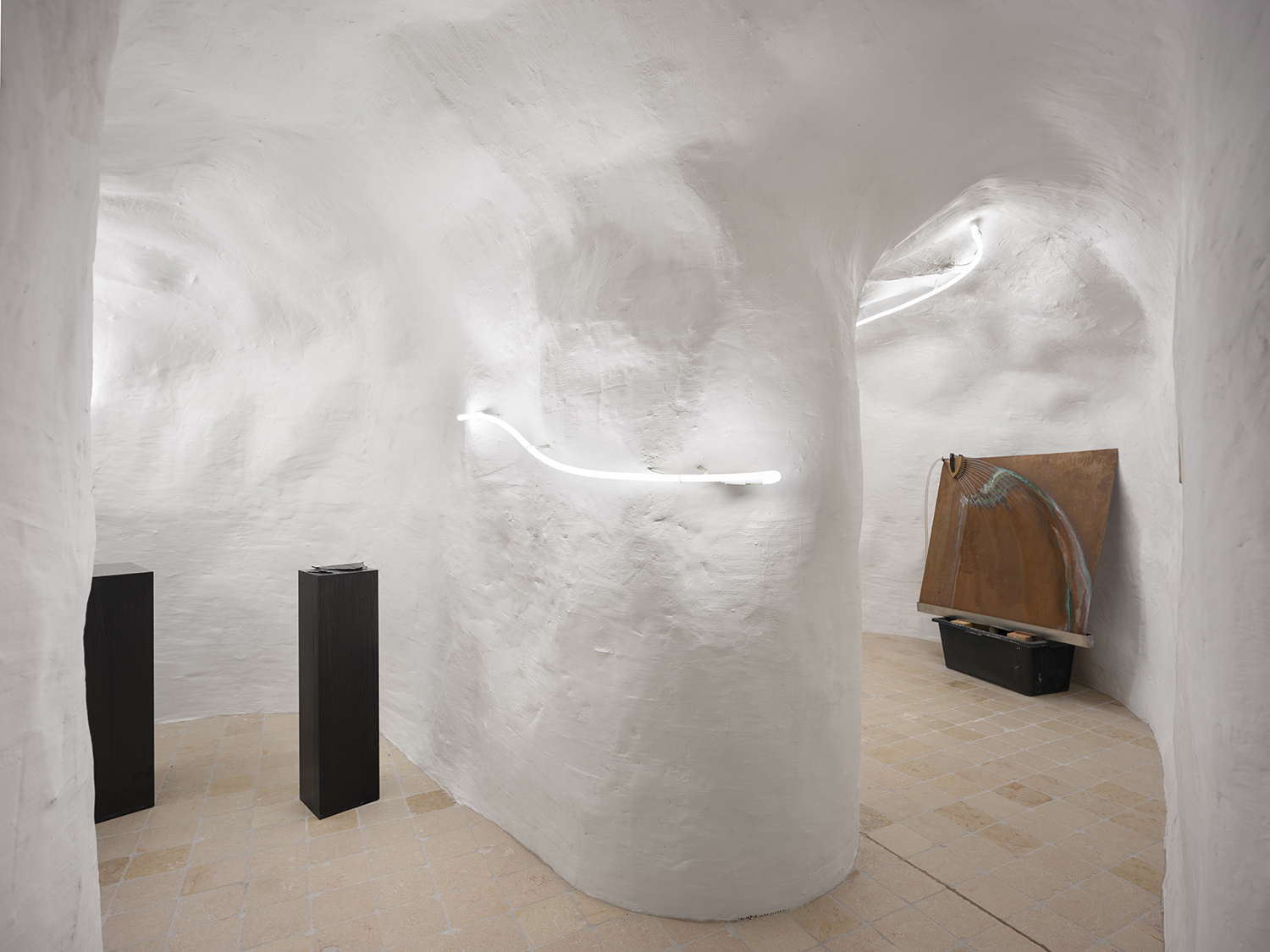
In 1939, Salvador Dalí participated to the World of the Tomorrow, a world’s fair that featured the future, with prospective designs from SOM, Norman Bel Geddes and other modernists and visionaries of the time. Dalí provoked the streamline futuristic foresight of those avant-garde actors with a surrealist tone and he made it so with a plaster-like architecture anticipating thus installation art, Gesamtkunstwerk works that would largely populate the 20th century art world. His intervention, an oneiric pavilion, freely reenacts Botticelli’s painting of Venus and transforms it into a three-dimensional and total experience. It constituted minor major piece of architecture that found its way to New York with the advice of no other than William Morris, father of socialist utopias and wallpapers. A much smaller scale and other rather trivial historical circumstances confronts the modest plaster to a luxurious context designed by a recognized modernist corporate practice of our time: Bjarke Ingels Group.
In an exhibition dedicated to the very presence of materials and its transformation, the art pieces of Nina Beier, Latifa Echakhch, Raphael Hefti, Olivier Laric and Christodoulos Panayiotou (among others), are found in a cave condition that the viewer discovers by diving into a seemingly undefined white grotto.
To stimulate the experience, the existing space is totally transformed to behind the plaster walls and vaults, bringing the visitor into close contact with the art pieces.
The usual white cube condition seems to have slightly melted as an echo to Dali’s delusive art, producing unclear edges in a spatial continuum or topological deformation.
Practising architecture in minor mode “requires a partial deconstruction of the structures of power that lead to their incessant reproduction” (Jill Stoner). Given the context, might be a quite (or too?) ambitious agenda for such a quasi-miniature intervention.
* Stoner, J. (2012). Toward a minor architecture. Cambridge: The MIT Press.
Drawings / Σχέδια
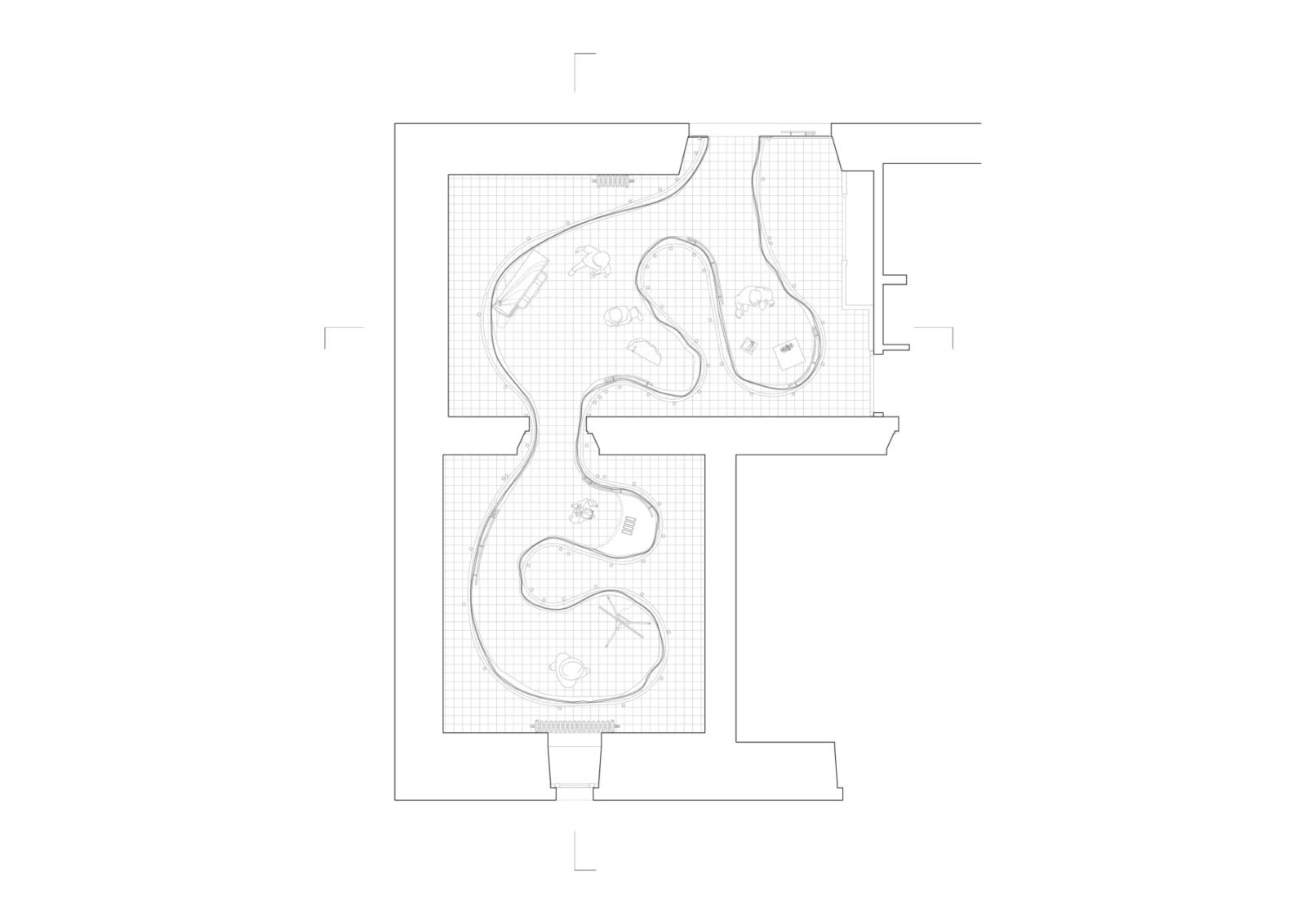
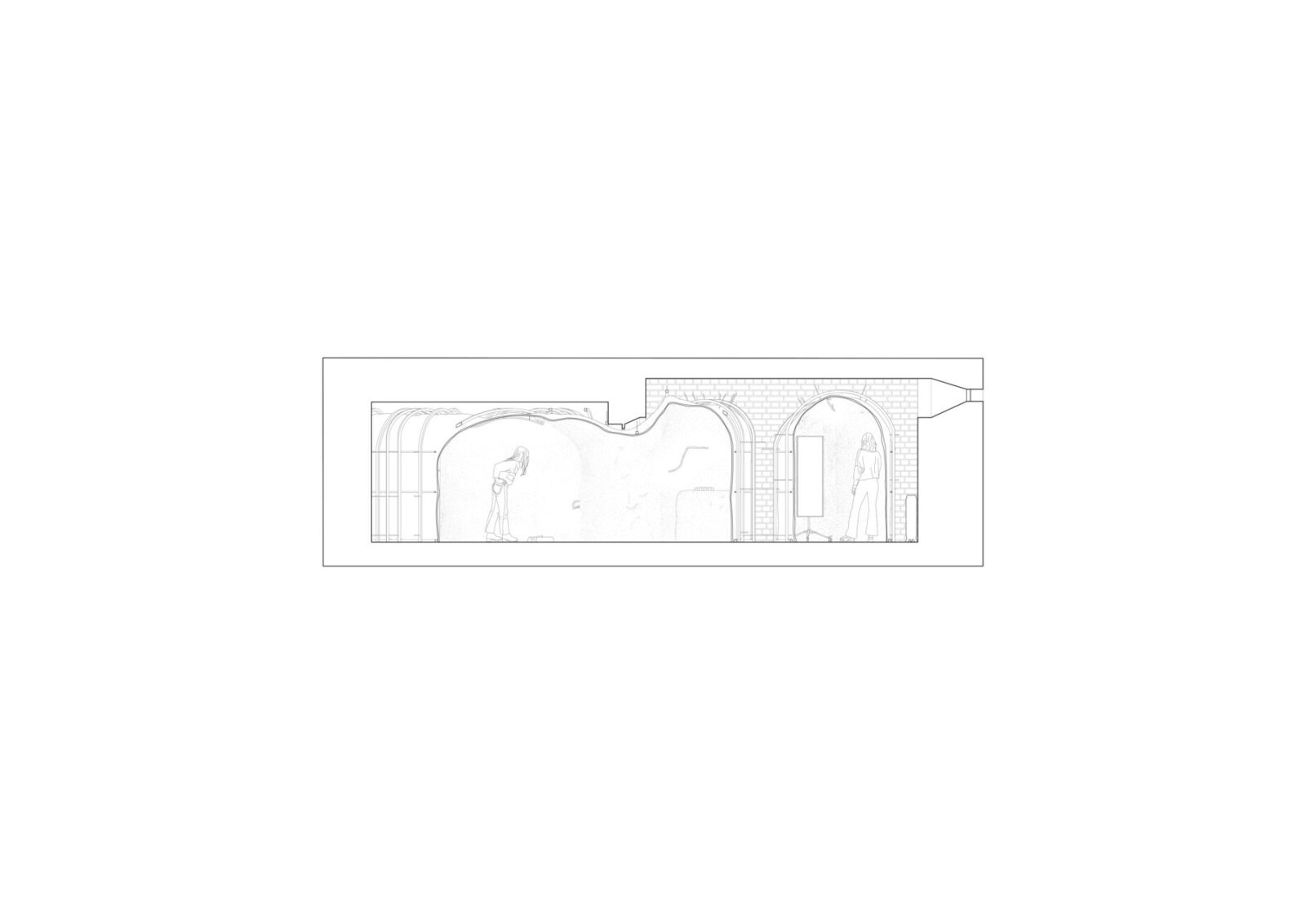
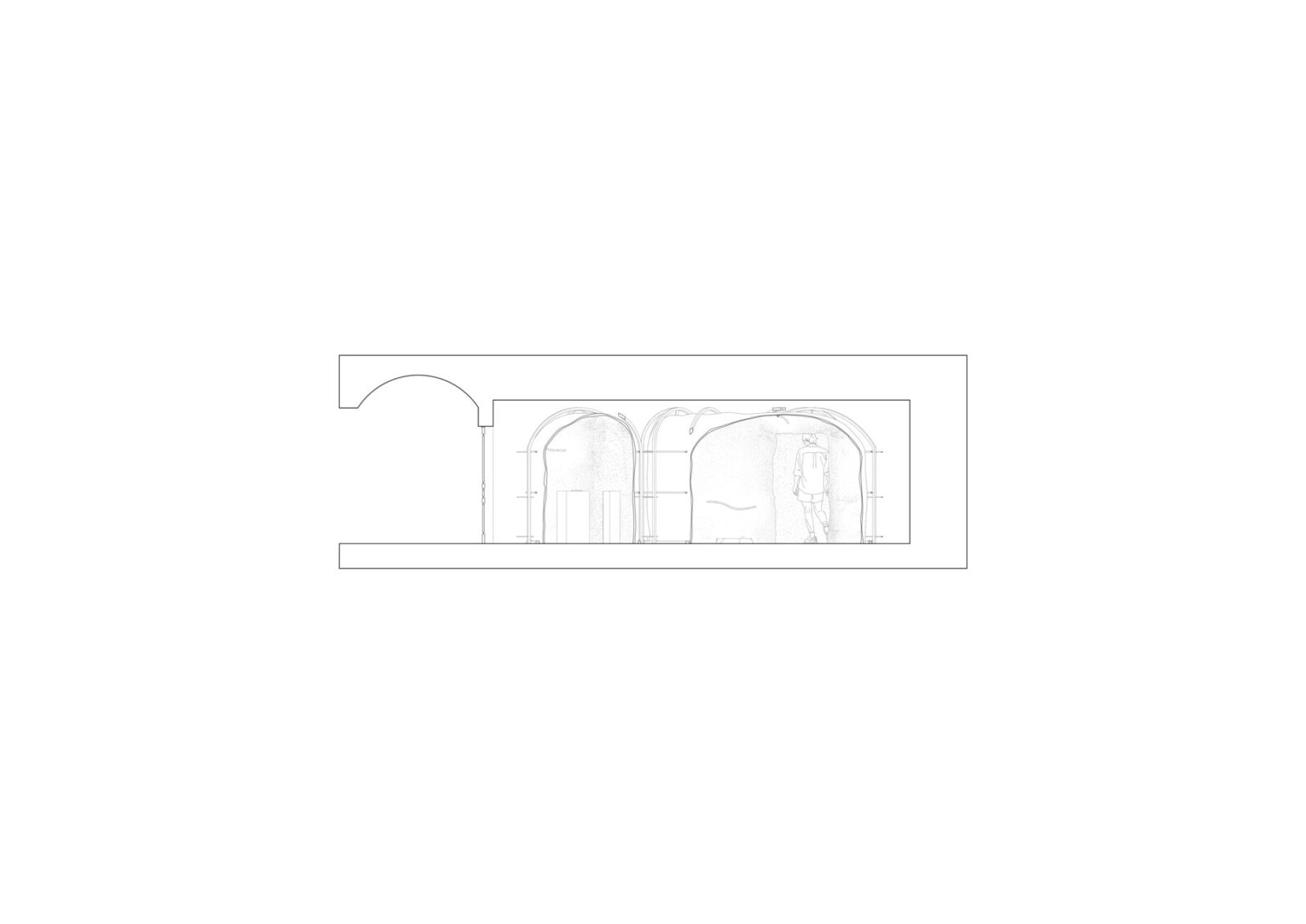
Facts & Credits
Project title Selenite Dreams
Typology Exhibition design, Interiors
Location Musée Atelier Audemars Piguet, Brassus, Switzerland (CH)
Area 24 sq.m.
Status Completed, 2022
Project team BUREAU (Daniel Zamarbide, Carine Pimenta, Galliane Zamarbide)
Concept design Daniel Zamarbide, Carine Pimenta, Jolan Haidinger
Project execution Carine Pimenta (project manager), Jolan Haidinger, Laëtitia Chauveau, Malak Abdelhady
Construction supervision Daniel Zamarbide, Galliane Zamarbide
Publication drawings Malak Abdelhady, Rui Da Silva
Context Temporary Exhibition for Audemars Piguet
Photography Dylan Perrenoud
Check out, also, the colourful design of ‘Distant Lights’ – Nuno Cera’s solo exhibition in Sines Arts Centre, Portugal by BUREAU, here!
READ ALSO: Case study: Tο Ελληνικό Ινστιτούτο Αρχιτεκτονικής στην εποχή της πληροφορίας
